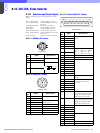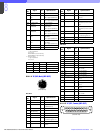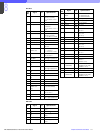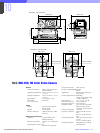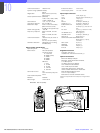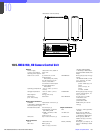
9
Chapter 9 Glossary – Terms and Definitions 176HDC-900/950/930 Series Product Information Manual
Scene file
A scene file is a place to temporally store the data that
differs from the normal settings. For instance, a
camera setting data made during rehearsal can be
stored in a scene file and then be recalled during an
actual take.
9-3. Camera characteristics
Most of the camera characteristics cannot just be
determined by numbers. Good values do not always
equal good picture quality. Judging by human eyes is
one of the most important processes to evaluate a
camera. The following are a few technical terms to be
familiar with:
Modulation depth
Modulation depth is used to measure a camera’s
fundamental performance. It shows a video level
percentage of a 0.5 MHz pulse wave in a subject so
that the 0.5 MHz pulse wave video level is 100% as
black to white, by shooting a Multi Burst chart while
Detail, Gamma, Matrix and Knee are off. The camera’s
performance is calculated by measuring the 0.5 MHz
response in the actual video bandwidth. Usually, the
frequency characteristics of the amplifier should be
kept flat, because if the level is raised too high, aliasing
noise will increase and the S/N becomes worse. In
actual shooting, picture quality is adjusted by adding
Detail signals to enhance the response.
Power consumption and heating
Power consumption is a factor that develops heat,
which is critical for shoulder-operating production
cameras although it is a little bit relaxed for studio
cameras. Using a cooling fan to reduce heating is not
a good solution, because the camera operator can
hear this noise. So, low power consumption is an
essential factor.
Reliability
Reliability is one of the most important factors when we
evaluate a camera. Unlike other broadcasting
equipment, cameras are often used outside under
severe circumstances such as live broadcasting of
skiing events below the freezing point or live
broadcasting of baseball in mid-summer, where
reliability always has first priority and a camera
malfunction is not acceptable.
Resolution
When we are talking about camera resolution, it usually
means horizontal resolution. It is calculated on how
many black and white lines that you can see
horizontally in a subject to that of the black and white
lines counted independently. For instance, a black line
and a white line are counted as two lines. When it is
converted to vertical resolution, because the definition
is how many lines can be seen vertically, it should be
revised with the aspect ratio. Therefore, even though
the horizontal pixel number is the same; resolution of
4:3 is better than that of 16:9.
Since the video signals of most of the cameras are
processed digitally, the resolution limit is fixed; this is
why the modulation depth has become to be regarded
as more important.
S/N (signal-to-noise ratio), Sensitivity and dynamic
range
When we are talking about camera S/N, it usually
means the S/N of black. The black level is amplified by
gamma and its gain greatly affects the S/N, which vary
between different manufacturers and even - different
models from the same manufacturer. Of course, users
also have different tastes. S/N is also changed by
different DTL settings. Usually, it is measured when
IRIS is closed, gamma is off, DTL is off, Chroma is off,
and the pedestal level is set at 5%.
There is a close relationship between S/N,
sensitivity, and dynamic range. When we raise the
sensitivity, the S/N and dynamic range will decrease.
So, it is difficult to decide to emphasize which item
while the other two items will be affected. Although the
measured value of the S/N is important, it seems that
the S/N judged by human eyes after gamma and DTL
are set is more important.
Weight and balance
Very naturally, less weight is better for shoulder-
operated equipment. However, balance is also a very
important factor. If the camera weight is too low, then
the overall balance of the camera will be off when a
large lens is attached.



